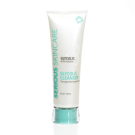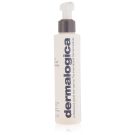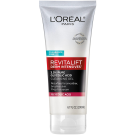
Top 10 Glycolic Acid Cleansers in 2023
What Is A Glycolic Acid Cleanser?
A glycolic acid cleanser is a type of facial cleanser that contains glycolic acid as its active ingredient. Glycolic acid is a type of alpha-hydroxy acid (AHA) derived from sugarcane. It is known for its exfoliating properties and is often used in skincare products to help improve the texture and appearance of the skin.
Glycolic acid cleansers are specifically formulated to cleanse the skin while also providing the benefits of glycolic acid. When applied to the skin, glycolic acid works by loosening the bonds between dead skin cells, thereby promoting exfoliation and revealing fresher, smoother skin underneath. It can help improve the skin’s tone and texture, reduce the appearance of fine lines and wrinkles, and unclog pores.
Common ingredients inside of a glycolic acid cleanser are as follows:
- Glycolic Acid: Of course, this is the primary ingredient. The concentration can vary between different cleansers, but it’s typically somewhere between 2% and 10%.
- Water: Like in most skincare products, water is often the primary ingredient as it serves as the base in which other ingredients are dissolved or suspended.
- Surfactants: These are used to help the product foam and cleanse the skin. Common surfactants include sodium lauryl sulfate (SLS), sodium laureth sulfate (SLES), and cocamidopropyl betaine.
- Humectants: These are substances that help to retain moisture in the skin. Glycerin and hyaluronic acid are common humectants used in skin cleansers.
- Aloe Vera: Often included for its soothing properties, which can help to offset the potential irritation from the glycolic acid.
- Chamomile Extract: This is another soothing ingredient that’s often included in glycolic acid cleansers.
- Preservatives: These are included to extend the shelf life of the product. Common preservatives include phenoxyethanol, parabens (though these are being used less frequently due to health concerns), and sodium benzoate.
- Thickeners: These are used to give the cleanser its texture. Common thickeners include carbomer and xanthan gum.
- Fragrance: Many cleansers include some type of fragrance to make the product pleasant to use.
It’s recommended to follow the instructions provided by the specific glycolic acid cleanser you choose, as the concentration of glycolic acid can vary between products. Additionally, if you have sensitive skin or any skin conditions, it’s advisable to consult a dermatologist before incorporating a glycolic acid cleanser into your skincare routine.
What Are The Benefits Of Glycolic Acid Cleansers?
Glycolic acid cleansers offer several benefits for the skin, particularly for those dealing with specific skin concerns or looking to improve their overall complexion. Here are some of the key benefits of using glycolic acid cleansers:
- Exfoliation: Glycolic acid is an alpha hydroxy acid (AHA) with small molecular size, which allows it to penetrate the skin more effectively. It works as an exfoliant, gently removing dead skin cells from the surface of the skin. This process helps to unclog pores, prevent acne breakouts, and improve overall skin texture, making it appear smoother and more radiant.
- Skin Brightening: By promoting exfoliation, glycolic acid cleansers can help fade dark spots, hyperpigmentation, and sunspots. Regular use can lead to a more even skin tone and a brighter complexion.
- Anti-Aging Properties: Glycolic acid stimulates collagen production in the skin. Collagen is a protein that helps maintain the skin’s firmness and elasticity. With consistent use, glycolic acid cleansers can help reduce the appearance of fine lines and wrinkles, leading to a more youthful-looking complexion.
- Improved Skin Absorption: Exfoliating the skin with glycolic acid can enhance the absorption of other skincare products. When dead skin cells are removed, serums, moisturizers, and other treatments can penetrate the skin more effectively, maximizing their benefits.
- Reduced Acne and Breakouts: By unclogging pores and removing dead skin cells, glycolic acid cleansers can help reduce acne and prevent future breakouts. It also has mild antibacterial properties that can help in controlling acne-causing bacteria.
- Oil Control: For those with oily skin, glycolic acid can help regulate sebum production, reducing excessive oiliness and shine.
- Minimized Pores: Regular use of glycolic acid can help reduce the appearance of enlarged pores, giving the skin a smoother and more refined look.
- Glowing Complexion: Due to its exfoliating properties, glycolic acid can reveal newer and healthier skin cells, leading to a more radiant and glowing complexion.
It’s important to note that glycolic acid can increase skin sensitivity to the sun, so it’s essential to wear sunscreen daily while using glycolic acid products, especially if you’re planning to spend time outdoors. Additionally, individuals with sensitive skin may need to use glycolic acid cleansers more sparingly or opt for lower concentrations to avoid irritation. As with any skincare product, it’s advisable to do a patch test before using a glycolic acid cleanser on your entire face to ensure compatibility with your skin. If you have any specific skin concerns or conditions, consult a dermatologist before incorporating glycolic acid into your skincare routine.
How We Graded The Best Cleansers With Glycolic Acid
Glycolic acid cleansers can vary in terms of their formulations, concentrations of glycolic acid, and additional ingredients. When it comes to grading them from best to worst, it ultimately depends on individual preferences, skin type, and specific skincare concerns. However, here are some general factors to consider when evaluating glycolic acid cleansers:
- Concentration of Glycolic Acid: The concentration of glycolic acid in the cleanser can impact its effectiveness. Higher concentrations (usually between 5% to 10%) may provide more noticeable exfoliation and skin-renewing benefits. However, if you have sensitive skin or are new to glycolic acid, starting with a lower concentration and gradually increasing it over time may be a better option.
- pH Balance: The pH level of a glycolic acid cleanser is important because it affects the acid’s efficacy. For optimal results, the cleanser should have a pH between 3 and 4, as this range allows glycolic acid to effectively exfoliate the skin.
- Additional Ingredients: Look for cleansers that contain other beneficial ingredients, such as hydrating agents (hyaluronic acid, glycerin), soothing extracts (aloe vera, chamomile), antioxidants (vitamin C, green tea extract), or nourishing oils. These ingredients can enhance the overall performance of the cleanser and provide additional skincare benefits.
- Product Reviews: Checking customer reviews and feedback can be helpful in assessing the efficacy and suitability of a glycolic acid cleanser. Reading about other people’s experiences with a particular product can give you insights into its effectiveness, potential side effects, and overall satisfaction.
- Personal Skin Type and Concerns: Consider your individual skin type and concerns. If you have sensitive or dry skin, you may prefer a gentler glycolic acid cleanser with lower concentrations. If you have oily or acne-prone skin, a cleanser with a higher concentration of glycolic acid may be more effective in targeting congestion and acne.
Remember, what works well for one person may not work the same way for another due to individual variations in skin type and sensitivity. It’s always advisable to perform a patch test and consult with a dermatologist if you have any concerns or specific skin conditions.
Our Top 10 Recommended Glycolic Acid Cleansers
Backed by a 30-day money back guarantee!
Frequently Asked Questions About Glycolic Acid Cleansers
What is glycolic acid and how does it work in a cleanser?
Glycolic acid is an alpha-hydroxy acid (AHA) derived from sugarcane. In a cleanser, it acts as an exfoliating agent by breaking down the bonds between dead skin cells, promoting cell turnover, and revealing smoother, brighter skin.
Are glycolic acid cleansers suitable for all skin types?
Glycolic acid cleansers are generally suitable for most skin types. However, individuals with sensitive or dry skin may need to start with lower concentrations and gradually increase usage to avoid potential irritation.
How often should I use a glycolic acid cleanser?
The frequency of use depends on your skin’s tolerance and the concentration of glycolic acid in the cleanser. It’s typically recommended to start with 2-3 times a week and gradually increase usage if your skin tolerates it well.
Can glycolic acid cleansers help with acne and breakouts?
Yes, glycolic acid cleansers can be beneficial for acne-prone skin. They help unclog pores, reduce excess oil production, and exfoliate dead skin cells, which can improve the appearance of acne and prevent future breakouts.
Will a glycolic acid cleanser make my skin more sensitive to the sun?
Yes, glycolic acid can increase skin sensitivity to sunlight. It’s important to apply sunscreen with a high SPF and take sun protection measures when using glycolic acid cleansers to minimize the risk of sunburn or hyperpigmentation.
Can I use a glycolic acid cleanser with other skincare products or treatments?
Yes, glycolic acid cleansers can be used in conjunction with other skincare products, but it’s important to be mindful of potential interactions or over-exfoliation. Avoid using them alongside other exfoliating products or treatments to prevent irritation.
Are there any potential side effects of using a glycolic acid cleanser?
Possible side effects of glycolic acid cleansers include redness, dryness, and mild stinging or tingling sensation. These effects are usually temporary and can be minimized by starting with lower concentrations and gradually increasing usage
Can glycolic acid cleansers help with anti-aging and reducing fine lines?
Yes, glycolic acid cleansers can help improve the appearance of fine lines and wrinkles by promoting cell turnover and stimulating collagen production, resulting in smoother and more youthful-looking skin.
Can I use a glycolic acid cleanser if I’m pregnant or breastfeeding?
It’s generally recommended to consult with a healthcare professional before using glycolic acid cleansers or any other skincare products during pregnancy or breastfeeding to ensure safety and suitability.
How long does it take to see results from a glycolic acid cleanser?
Results can vary depending on individual skin and the specific concerns being addressed. Some people may notice improvements in skin texture and brightness within a few weeks of regular use, while others may require more time for noticeable results.
Remember to consider individual skin sensitivities and follow the instructions provided by the specific glycolic acid cleanser you choose. If you have any concerns or specific skin conditions, it’s best to consult a dermatologist for personalized advice
About The Author

Dr. Katie Belesney
COSMETIC DERMATOLOGIST & BEAUTY ENTHUSIAST
Dr. Katie Belesney is a licensed Cosmetic Dermatologist, beauty enthusiast, and holistic health coach who has a passion for helping men and women look their best. She loves writing and educating everyday people through her blog Beauty List Review.









